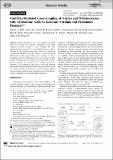Files in this item
Cu(OTf)2-mediated cross-coupling of nitriles and N-heterocycles with arylboronic acids to generate nitrilium and pyridinium products
Item metadata
| dc.contributor.author | Bell, Nicola | |
| dc.contributor.author | Xu, Chao | |
| dc.contributor.author | Fyfe, Jamie | |
| dc.contributor.author | Vantourout , Julien C. | |
| dc.contributor.author | Brals, Jeremy | |
| dc.contributor.author | Chabbra, Sonia | |
| dc.contributor.author | Bode, Bela E. | |
| dc.contributor.author | Cordes, David B. | |
| dc.contributor.author | Slawin, Alexandra M. Z. | |
| dc.contributor.author | McGuire, Thomas M. | |
| dc.contributor.author | Watson, Allan J. B. | |
| dc.date.accessioned | 2021-02-26T11:30:01Z | |
| dc.date.available | 2021-02-26T11:30:01Z | |
| dc.date.issued | 2021-03-29 | |
| dc.identifier | 272350142 | |
| dc.identifier | 172ab71c-27a4-40ca-b425-aec8626bcb34 | |
| dc.identifier | 85101660531 | |
| dc.identifier | 000621803100001 | |
| dc.identifier.citation | Bell , N , Xu , C , Fyfe , J , Vantourout , J C , Brals , J , Chabbra , S , Bode , B E , Cordes , D B , Slawin , A M Z , McGuire , T M & Watson , A J B 2021 , ' Cu(OTf) 2 -mediated cross-coupling of nitriles and N-heterocycles with arylboronic acids to generate nitrilium and pyridinium products ' , Angewandte Chemie International Edition , vol. 60 , no. 14 , pp. 7935-7940 . https://doi.org/10.1002/anie.202016811 | en |
| dc.identifier.issn | 1433-7851 | |
| dc.identifier.other | ORCID: /0000-0002-9527-6418/work/89627884 | |
| dc.identifier.other | ORCID: /0000-0002-5366-9168/work/89627962 | |
| dc.identifier.other | ORCID: /0000-0002-3384-271X/work/89628055 | |
| dc.identifier.other | ORCID: /0000-0002-1582-4286/work/89628279 | |
| dc.identifier.uri | https://hdl.handle.net/10023/21513 | |
| dc.description | Funding: Leverhulme Trust (Grant Number(s): RPG-2015-308), Leverhulme Trust (Grant Number(s): RPG-2018-362), Engineering and Physical Sciences Research Council (Grant Number(s): EP/R025754/1). | en |
| dc.description.abstract | Metal‐catalyzed C–N cross‐coupling generally forms C–N bonds by reductive elimination from metal complexes bearing covalent C‐ and N‐ligands. We have identified a Cu‐mediated C–N cross‐coupling that uses a dative N‐ligand in the bond forming event, which, in contrast to conventional methods, generates reactive cationic products. Mechanistic studies suggest the process operates via transmetalation of an aryl organoboron to a Cu(II) complex bearing neutral N‐ligands, such as nitriles or N‐heterocycles. Subsequent generation of a putative Cu(III) complex enables the oxidative C–N coupling to take place, delivering nitrilium intermediates and pyridinium products. The reaction is general for a range of N(sp) and N(sp2) precursors and can be applied to drug synthesis and late‐stage N‐arylation, and the limitations in the methodology are mechanistically evidenced. | |
| dc.format.extent | 7 | |
| dc.format.extent | 2223421 | |
| dc.language.iso | eng | |
| dc.relation.ispartof | Angewandte Chemie International Edition | en |
| dc.subject | Arylation | en |
| dc.subject | Boron | en |
| dc.subject | Copper | en |
| dc.subject | Cross-coupling | en |
| dc.subject | Mechanism | en |
| dc.subject | QD Chemistry | en |
| dc.subject | DAS | en |
| dc.subject.lcc | QD | en |
| dc.title | Cu(OTf)2-mediated cross-coupling of nitriles and N-heterocycles with arylboronic acids to generate nitrilium and pyridinium products | en |
| dc.type | Journal article | en |
| dc.contributor.sponsor | The Leverhulme Trust | en |
| dc.contributor.sponsor | EPSRC | en |
| dc.contributor.institution | University of St Andrews. Sir James Mackenzie Institute for Early Diagnosis | en |
| dc.contributor.institution | University of St Andrews. School of Chemistry | en |
| dc.contributor.institution | University of St Andrews. EaSTCHEM | en |
| dc.contributor.institution | University of St Andrews. Biomedical Sciences Research Complex | en |
| dc.contributor.institution | University of St Andrews. Centre of Magnetic Resonance | en |
| dc.identifier.doi | https://doi.org/10.1002/anie.202016811 | |
| dc.description.status | Peer reviewed | en |
| dc.identifier.grantnumber | RPG-2015-308 | en |
| dc.identifier.grantnumber | EP/R025754/1 | en |
This item appears in the following Collection(s)
Items in the St Andrews Research Repository are protected by copyright, with all rights reserved, unless otherwise indicated.

